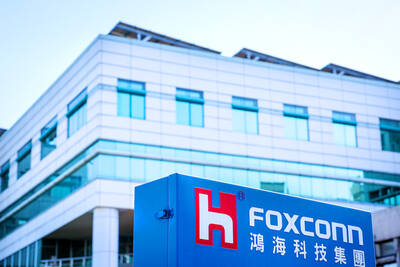Yageo Corp (國巨), the world’s No. 3 multilayer ceramic capacitor (MLCC) supplier, yesterday said that revenue would continue to grow sequentially this quarter, driven by resilient customer demand for premium passive components used in notebook computers, data centers and 5G-related devices.
The growth momentum is reflected in the firm’s strong book-to-bill ratio of 1.5, company chairman Pierre Chen (陳泰銘) told an online investors’ conference yesterday.
Lead times for high-end passive components stand at eight to 10 months, while Yageo only needs three months to ship standard passive components to its customers, Chen said.

Photo: Chang Hui-wen, Taipei Times
Yageo’s inventory has maintained at a low level of 60 days, he added.
“We have heard some noise about inventory in the standard product market. We are not concerned about demand in the premium market. Momentum in the premium market continues to build. We can continue to expect growth in the third quarter,” Chen said.
As it continues to expand in high-end markets, Yageo is confident that over the next two to three years, it can outpace the industry’s annual growth rate of 3 to 10 percent, Chen said.
In three years, premium products are expected to contribute 80 percent of total revenue, up from 75 percent, while standard products are likely to contribute 20 percent, down from 25 percent, Chen said.
The shift would help Yageo maintain a gross margin of more than 40 percent in the long term, as premium products tend to have a gross margin of more than 35 percent, he said.
In the long term, passive components used in vehicles are expected to be major drivers of growth, so the company plans to allocate 40 to 50 percent of the capacity at its new fab in Kaohsiung to that, Chen said, adding that the fab is under construction and would start production next year.
Yageo reported second-quarter net profit of NT$6.33 billion (US$225.49 million), an 11-quarter high and an increase of 92 percent annually, up from NT$3.3 billion, and 26 percent quarterly, up from NT$5.02 billion.
Earnings per share increased to NT$12.81, up from NT$7.01 a year earlier and NT$10.17 in the first quarter. Gross margin fell to 41 percent from 44.3 percent last year, but improved from 39.1 percent in the first quarter.
Yageo expects this quarter’s gross margin to resemble last quarter’s.
Revenue last quarter doubled to NT$27.71 billion from NT$13.47 billion last year, mostly due to the acquisition of US-based Kemet Corp. On a quarterly basis, revenue increased 16.7 percent, up from NT$23.75 billion.
MLCCs contributed the most revenue last quarter at 29 percent, followed by tantalum at 21 percent and chip resistors at 19 percent.

Hon Hai Precision Industry Co (鴻海精密) yesterday said that its research institute has launched its first advanced artificial intelligence (AI) large language model (LLM) using traditional Chinese, with technology assistance from Nvidia Corp. Hon Hai, also known as Foxconn Technology Group (富士康科技集團), said the LLM, FoxBrain, is expected to improve its data analysis capabilities for smart manufacturing, and electric vehicle and smart city development. An LLM is a type of AI trained on vast amounts of text data and uses deep learning techniques, particularly neural networks, to process and generate language. They are essential for building and improving AI-powered servers. Nvidia provided assistance

DOMESTIC SUPPLY: The probe comes as Donald Trump has called for the repeal of the US$52.7 billion CHIPS and Science Act, which the US Congress passed in 2022 The Office of the US Trade Representative is to hold a hearing tomorrow into older Chinese-made “legacy” semiconductors that could heap more US tariffs on chips from China that power everyday goods from cars to washing machines to telecoms equipment. The probe, which began during former US president Joe Biden’s tenure in December last year, aims to protect US and other semiconductor producers from China’s massive state-driven buildup of domestic chip supply. A 50 percent US tariff on Chinese semiconductors began on Jan. 1. Legacy chips use older manufacturing processes introduced more than a decade ago and are often far simpler than

STILL HOPEFUL: Delayed payment of NT$5.35 billion from an Indian server client sent its earnings plunging last year, but the firm expects a gradual pickup ahead Asustek Computer Inc (華碩), the world’s No. 5 PC vendor, yesterday reported an 87 percent slump in net profit for last year, dragged by a massive overdue payment from an Indian cloud service provider. The Indian customer has delayed payment totaling NT$5.35 billion (US$162.7 million), Asustek chief financial officer Nick Wu (吳長榮) told an online earnings conference. Asustek shipped servers to India between April and June last year. The customer told Asustek that it is launching multiple fundraising projects and expected to repay the debt in the short term, Wu said. The Indian customer accounted for less than 10 percent to Asustek’s

Gasoline and diesel prices this week are to decrease NT$0.5 and NT$1 per liter respectively as international crude prices continued to fall last week, CPC Corp, Taiwan (CPC, 台灣中油) and Formosa Petrochemical Corp (台塑石化) said yesterday. Effective today, gasoline prices at CPC and Formosa stations are to decrease to NT$29.2, NT$30.7 and NT$32.7 per liter for 92, 95 and 98-octane unleaded gasoline respectively, while premium diesel is to cost NT$27.9 per liter at CPC stations and NT$27.7 at Formosa pumps, the companies said in separate statements. Global crude oil prices dropped last week after the eight OPEC+ members said they would